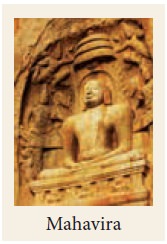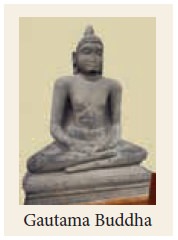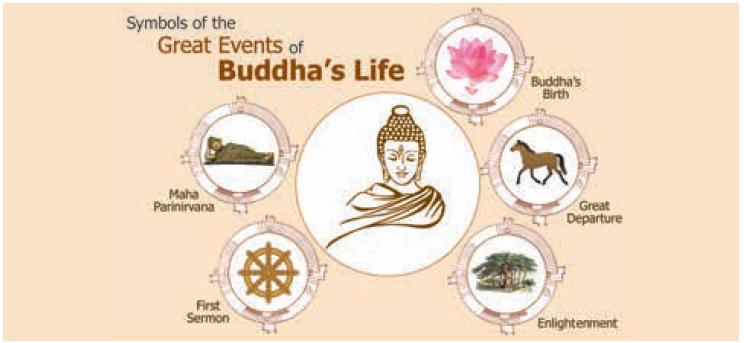History - Jainism and Buddhism | 9th Social Science : History : Intellectual Awakening and Socio-Political Changes
Chapter: 9th Social Science : History : Intellectual Awakening and Socio-Political Changes
Jainism and Buddhism
Jainism and Buddhism
In the Gangetic plain, iron plough agriculture
required the use of bullocks. But the indiscriminate killing of cattle for
Vedic rituals and sacrifices caused resentment. The founders of Jainism and
Buddhism did not prescribe killing as a religious rite. They secured their
livelihood mostly by alms. Celibacy and abstinence from holding property made
the new teachers much more acceptable than the Brahman priests. The people’s
resentment about the expensive and elaborate Vedic rituals, animal sacrifice
and the desire for wealth eventually took them towards Jainism and Buddhism.
Mahavira and Buddha lived a life of purity and
exemplified simplicity and self-denial. They lived in the times of Bimbisara
and Ajatashatru, the famous kings of Magadha. The commercial development of the
northern cities like Kaushambi, Kushinagara, Benaras, Vaishali and Rajgir added
importance to the Vaishyas who turned to Buddhism and Jainism in their
eagerness to improve their social status.
Jainism
Mahavira: Birth and Life
Vardhamana Mahavira was born in 599 BCE at Kundagrama near Vaishali. His mother was Trishala, a Lichchavi princess. He spent his early life as a prince and was married to a princess named Yashoda. The couple had a daughter. At the age of thirty, he left his home and became an ascetic. For over twelve years, Mahavira wandered from place to place, subjecting himself to severe penance and self-mortification. In the thirteenth year of his asceticism, he acquired the highest knowledge and came to be known as Jaina (the conqueror) and Mahavira (great hero). Jains believe that Mahavira came in a long line of Tirthankaras and he was the twenty fourth and the last of them. Rishabha was the first Tirthankara and Parshvanath the penultimate or the twenty third. Mahavira travelled extensively as a preacher in the kingdoms of Magadha, Videha and Anga. Magadha rulers Bimbisara and Ajatashatru were influenced by his teachings. Thousands of people became his followers. After 30 years of preaching, Mahavira died at Pawapuri in 527 BCE at the age of seventy two.

Teachings of Mahavira
The three principles of Jainism, also known as
Tri-ratnas, are the following:
·
Right faith: Belief in the teachings and wisdom of
Mahavira.
·
Right knowledge: Acceptance of the theory that
there is no God and that the world existed without a creator.
·
Right action: It refers to the Mahavira’s
observance of the five great vows: (a) ahimsa, (b) honesty, (c) kindness, (d)
truthfulness and (e) not coveting or desiring things belonging to others.
Spread of Jainism
Inordertospreadhisnewfaith,Mahavira founded
monasteries and engaged munis (Jaina monks) who led a very austere life. In
North India, this new faith was patronised by rulers such as Dhana Nanda,
Chadragupta Maurya and Kharavela. There was a notable following for Jainism in
Karnataka and western India during the 4th century BCE. Jainism encouraged the
public spirit among all who embraced it. Varna system practiced by Brahmans was
challenged. People were spared from the costly and elaborate rituals and
sacrifices. Mahavira believed that all objects, both animate and inanimate,
have souls and various degrees of consciousness. They possess life and feel
pain when they are injured.
Split in Jainism
In course of time, Jainism split into two branches,
namely the Digambaras (sky-clad) and the Svetambaras (white- clad). The
Digambaras were the orthodox followers of Mahavira. The Digambaras rejected
clothes altogether. Svetambaras wore a white dress from head to toe.
Decline of Jainism
The lack of royal patronage, its severity,
factionalism and spread of Buddhism led to the decline of Jainism in India.
Buddhism
Gautama Buddha: Birth and Life
Gautama Buddha was the son of Suddhodana, the chief of a Kshatriya clan of the Sakyas of Kapilavastu in present-day Nepal. His given name was Siddhartha. Gautama Buddha As he belonged to the Sakya clan, he was also known as ‘Sakya Muni’. He was born in 567 BCE in Lumbini Garden, near Kapilavastu. His mother, Mayadevi (Mahamaya), died after a few days of his birth and he was brought up by his step-mother. In order to divert his attention towards worldly affairs, his father got him married at the age of sixteen to a princess called Yashodhara. He led a happy married life for some time and had a son by name Rahula.

One evening, while Siddhartha was passing through
the city, he came across an old man who had been abandoned by his relatives, a
sick man crying with pain and a dead body surrounded by weeping relatives.
Siddhartha was deeply moved by these sights. He also saw an ascetic who had
renounced the world and found no sign of sorrows. These ‘Four Great Sights’
prompted him to renounce the world and search for the cause of suffering. In
537 BCE, he left his palace and went into the forest in search of truth. In the
course of his wanderings, he sat under a peepal tree for several days until he
attained enlightenment. The place where he attained enlightenment, the
Mahabodhi temple, still exists in Bodh Gaya (Bihar).
After his enlightenment, Buddha decided to impart
his knowledge to the people. He went to Varanasi and gave his first sermon at
Saranath. He preached in the kingdoms of Magadha and Kosala. A large number of
people became his followers including his own family. After forty five years of
preaching, he breathed his last in 487 BCE at Kushinagar (near Gorakhpur in
Uttar Pradesh) at the age of eighty.
Teachings of Buddhism
i.
Four
Great Truths: (1) There is
suffering and sorrow in this world. The cause of human suffering is desire
and craving. (3) This pain or sorrow can be removed by suppressing desire and
craving. (4) This is to be achieved by leading a disciplined life or by
following what Buddha called the ‘Noble Eight-fold Path’.
ii.
Attainment
of Nirvana: According to
Buddha, a person should aim at attainment of nirvana or the highest bliss, and
it could be achieved by any person by leading a virtuous life and by following
the Noble Eight-fold Path.
iii.
The Noble
Eight-fold Path: Buddha preached
a new path to attain the purest state of mind: (1) right views, right
aspirations, (3) right speech, right action, (5) right livelihood, right
effort, (7) right mindfulness and (8) right contemplations or meditation.
Buddha preached that he who practices the eight-fold path can attain the
highest and purest state of mind.
iv.
Middle
Path and Salvation: Buddha advised
his followers neither to indulge in material pleasures and luxuries nor to practice
austere penances. He said that by following the ‘Middle Path’, people could
attain moksha or salvation, that is freedom from the cycle of birth, death and
rebirth.
v.
Ahimsa or
Non-violence was another fundamental
belief of Buddha. He condemned bloody sacrifices in the yajnas. According to
him, love for all living beings was an essential disposition for a good
practitioner of Buddhism.
vi.
![]() Emphasis on Morality: Buddha
advised his followers to do good deeds and lead a moral and disciplined
life. He appealed to them to refrain from lying, from killing living beings,
from taking intoxicants, from stealing and from leading a sensual life.
Emphasis on Morality: Buddha
advised his followers to do good deeds and lead a moral and disciplined
life. He appealed to them to refrain from lying, from killing living beings,
from taking intoxicants, from stealing and from leading a sensual life.

Spread of Buddhism
Buddha, in order to carry his message to different
parts of India, established the Buddhist sangha
or the Holy Order of Monks. The bikshus
(monks) and the bikshunis (nuns) were
enlisted for spreading the faith and
they were required to lead a life of purity and poverty. Buddhism spread to
Central Asia, Sri Lanka, Tibet, Southeast
Asia, as well as the eastern countries of China,
Mongolia, Korea, Japan and Vietnam.
The Split in Buddhism
During the reign of Kanishka, the Buddhist monk
Nagarjuna initiated reforms in the way Buddhism was being followed. As a
result, Buddhism was split into two as Hinayana
and Mahayana.
I.
The Hinayana
(Lesser Vehicle) was the original creed preached by Buddha. The followers of
this form regarded Buddha as their guru and did not worship him as God. They
denied idol worship and continued with the people’s language, Pali.
II.
In Mahayana (Greater
Vehicle), Buddha was worshipped as God and Bodhisattuva as his previous avatar.
The followers made images and statues of Buddha and Bodhisattuva and offered
prayers, and recited hymns (mantras) in
their praise. Later, they wrote their religious books in Sanskrit. This form of
Buddhism was patronised by Kanishka.
Decline of Buddhism
Buddhism declined in India due to the following
reasons:
1. Buddhism
was popular in the beginning because it was preached in people’s language
(Pali). The later texts were written in Sanskrit, which was difficult for the
common people to understand.
2. The split
in Buddhism into Hinayana and Mahayana was another vital reason. Image worship
in Mahayana made no difference between Hinduism and Buddhism.
3. Buddhism
lost its royal patronage during the reign of Guptas.
4. Further,
the invasions of Huns and Turks almost wiped out Buddhism.
Related Topics